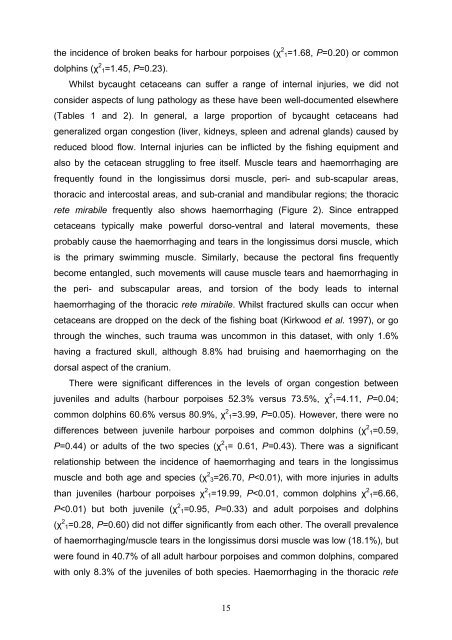The Animal Welfare Implications of Cetacean Deaths in Fisheries
The Animal Welfare Implications of Cetacean Deaths in Fisheries
The Animal Welfare Implications of Cetacean Deaths in Fisheries
You also want an ePaper? Increase the reach of your titles
YUMPU automatically turns print PDFs into web optimized ePapers that Google loves.
the <strong>in</strong>cidence <strong>of</strong> broken beaks for harbour porpoises (χ 2 1=1.68, P=0.20) or common<br />
dolph<strong>in</strong>s (χ 2 1=1.45, P=0.23).<br />
Whilst bycaught cetaceans can suffer a range <strong>of</strong> <strong>in</strong>ternal <strong>in</strong>juries, we did not<br />
consider aspects <strong>of</strong> lung pathology as these have been well-documented elsewhere<br />
(Tables 1 and 2). In general, a large proportion <strong>of</strong> bycaught cetaceans had<br />
generalized organ congestion (liver, kidneys, spleen and adrenal glands) caused by<br />
reduced blood flow. Internal <strong>in</strong>juries can be <strong>in</strong>flicted by the fish<strong>in</strong>g equipment and<br />
also by the cetacean struggl<strong>in</strong>g to free itself. Muscle tears and haemorrhag<strong>in</strong>g are<br />
frequently found <strong>in</strong> the longissimus dorsi muscle, peri- and sub-scapular areas,<br />
thoracic and <strong>in</strong>tercostal areas, and sub-cranial and mandibular regions; the thoracic<br />
rete mirabile frequently also shows haemorrhag<strong>in</strong>g (Figure 2). S<strong>in</strong>ce entrapped<br />
cetaceans typically make powerful dorso-ventral and lateral movements, these<br />
probably cause the haemorrhag<strong>in</strong>g and tears <strong>in</strong> the longissimus dorsi muscle, which<br />
is the primary swimm<strong>in</strong>g muscle. Similarly, because the pectoral f<strong>in</strong>s frequently<br />
become entangled, such movements will cause muscle tears and haemorrhag<strong>in</strong>g <strong>in</strong><br />
the peri- and subscapular areas, and torsion <strong>of</strong> the body leads to <strong>in</strong>ternal<br />
haemorrhag<strong>in</strong>g <strong>of</strong> the thoracic rete mirabile. Whilst fractured skulls can occur when<br />
cetaceans are dropped on the deck <strong>of</strong> the fish<strong>in</strong>g boat (Kirkwood et al. 1997), or go<br />
through the w<strong>in</strong>ches, such trauma was uncommon <strong>in</strong> this dataset, with only 1.6%<br />
hav<strong>in</strong>g a fractured skull, although 8.8% had bruis<strong>in</strong>g and haemorrhag<strong>in</strong>g on the<br />
dorsal aspect <strong>of</strong> the cranium.<br />
<strong>The</strong>re were significant differences <strong>in</strong> the levels <strong>of</strong> organ congestion between<br />
juveniles and adults (harbour porpoises 52.3% versus 73.5%, χ 2 1=4.11, P=0.04;<br />
common dolph<strong>in</strong>s 60.6% versus 80.9%, χ 2 1=3.99, P=0.05). However, there were no<br />
differences between juvenile harbour porpoises and common dolph<strong>in</strong>s (χ 2 1=0.59,<br />
P=0.44) or adults <strong>of</strong> the two species (χ 2 1= 0.61, P=0.43). <strong>The</strong>re was a significant<br />
relationship between the <strong>in</strong>cidence <strong>of</strong> haemorrhag<strong>in</strong>g and tears <strong>in</strong> the longissimus<br />
muscle and both age and species (χ 2 3=26.70, P
















